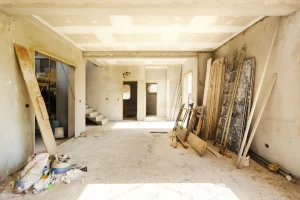Freehold Block of Flats Insurance: Top Cover Tips

When selecting an insurance policy, factors such as the type of tenants, unoccupied flats, and the risk of water leaks and subsidence should be taken into account. It’s essential to accurately determine the rebuild cost of the property and disclose any claims history. If there are joint freeholders, their details may be required for the policy.
Key aspects to consider when buying buildings insurance include reviewing the policy’s exclusions, understanding excesses, comparing premiums, and evaluating the level of customer service provided by the insurer. Taking the time to choose the right insurance policy will provide you with peace of mind and protect your investment.
Key Takeaways:
Choose a specialised block of flats insurance policy rather than a standard home insurance policy.
Buildings insurance covers the physical structure of the property.
Consider additional covers like public liability and landlord home emergency.
Accurately determine the rebuild cost of the property and disclose any claims history.
Review the policy’s exclusions, understand excesses, and compare premiums.
What is Block of Flats Insurance?
Block of flats insurance primarily includes buildings insurance, which is required by the leases for the individual flats. It covers the physical structure of the property and ensures that mortgage lenders can provide financing for the flats. It is important to inform the insurer about the occupancy of the flats, including any unoccupied flats, as they may pose higher risks. Other factors such as different types of tenants and the need for additional covers like public liability and landlord home emergency should also be considered.
When it comes to insuring a block of flats, having the right coverage is vital to protect your investment. Block of flats insurance primarily consists of buildings insurance, which is a requirement imposed by the leases for the individual flats. This type of insurance is designed to safeguard the physical structure of the property, providing financial protection in the event of damage or loss due to various risks.
Buildings insurance ensures that mortgage lenders can provide financing for the flats, as it protects their investment. In addition, it provides peace of mind to the property owner by offering financial security for the building itself.
When obtaining a block of flats insurance policy, it is crucial to inform the insurer about the occupancy of the flats. This includes providing details about any unoccupied flats, as they may pose higher risks due to increased vulnerability to theft, vandalism, or damage. By providing accurate information about the occupancy, you can ensure that your insurance policy covers these potential risks appropriately.
Furthermore, different types of tenants in the block of flats may also require additional considerations. For instance, student tenants or tenants with pets may have specific insurance requirements that need to be addressed in the policy. Discussing these details with the insurer will help ensure that the coverage adequately meets the needs of the property and its occupants.
In addition to buildings insurance, block of flats insurance may also include other covers, such as public liability insurance and landlord home emergency cover. Public liability insurance protects the property owner from potential legal claims if someone injures themselves on the property. Landlord home emergency cover provides financial assistance for urgent repairs or emergencies, such as burst pipes or broken heating systems.
Overall, block of flats insurance is a comprehensive insurance solution that protects the physical structure of the property and provides financial security for the property owner. By selecting a policy that aligns with the unique needs of your block of flats, you can have peace of mind knowing that your investment is adequately protected.
What Does Buildings Insurance Cover for a Block of Flats?
Buildings insurance for a block of flats provides comprehensive coverage for the physical construction of the property. It safeguards the structural elements, including the walls, flooring, and enduring fixtures and fittings such as fitted kitchens and bathrooms. This insurance ensures that in the event of unforeseen damages or disasters, the property owners are protected against financial loss and can reconstruct the building to its original state.
One of the key benefits of buildings insurance is protection against water leaks, which can cause extensive damage to the property. It covers the cost of repairs or replacement in case of burst pipes or plumbing issues that result in water damage. This coverage is particularly crucial for block of flats, as even a small leak can affect multiple units and cause significant inconvenience and financial loss.
Another risk that buildings insurance covers is subsidence. Subsidence occurs when the ground beneath the property sinks or shifts, leading to cracks in the walls or other structural damage. Buildings insurance provides financial protection for repairing the damage caused by subsidence and ensures the stability and safety of the block of flats.
“Buildings insurance for a block of flats protects the property owners against unexpected costs arising from physical damages to the building and its fixtures and fittings. It is a vital safeguard that offers peace of mind and financial security for property owners.”
In the unfortunate event of a disaster such as a fire or severe weather conditions, buildings insurance may fully cover the cost of reconstructing the building. This coverage not only includes the physical structure but also the necessary repairs or replacements for fixtures and fittings. It ensures that the block of flats can be restored to its original condition, allowing tenants to return to their homes and resume normalcy.
Having buildings insurance for a block of flats is essential for property owners to protect their investment and mitigate the financial risks associated with unforeseen damages. It ensures that the physical construction of the property, including the walls, flooring, fixtures, and fittings, is adequately covered. In the event of water leaks, subsidence, or the need for reconstructing the building, this insurance provides the necessary financial support to handle the costs and restore the property.
Coverage
Benefits
Physical structure of the property (walls, flooring, etc.)
Comprehensive protection against damages and disasters
Fixtures and fittings (kitchens, bathrooms, etc.)
Ensures necessary repairs or replacements
Water leaks
Covers the cost of repairs for burst pipes or plumbing issues
Subsidence
Financial support for repairing damage caused by ground movement
Reconstructing the building
Full coverage for restoring the block of flats to its original state
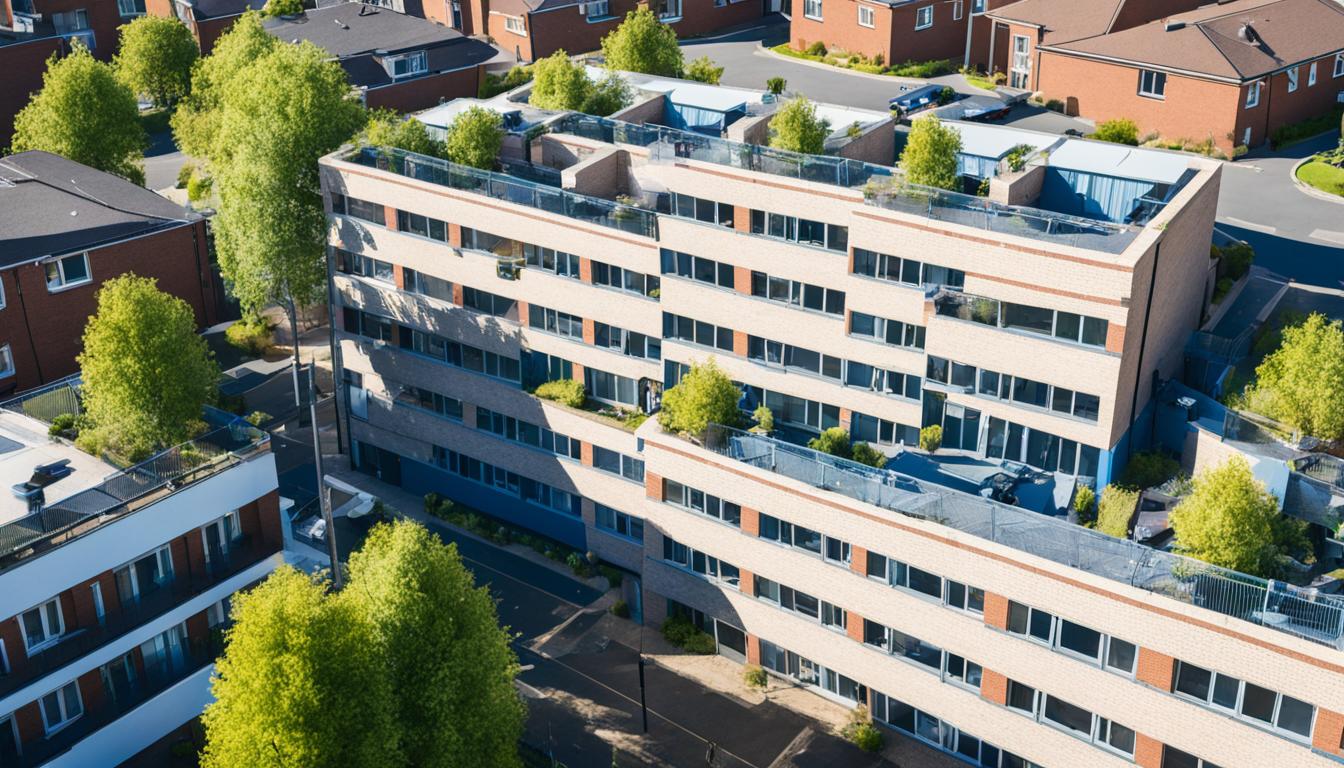
Things to Consider for Your Block Insurance Policy
When obtaining block insurance for your property, it’s crucial to carefully consider several factors to ensure adequate coverage and protection. These factors include:
Rebuild Cost: Determine the accurate rebuild cost of the property. This is the amount it would take to rebuild the property from scratch, including materials and labor.
Occupancy: Accurately identify the occupancy of the flats within the block. Different types of tenants may present different risks, and unoccupied flats may require special coverage.
Claims History: Disclose any previous insurance claims made on the property, including the date, total cost, and details of the claim. This information helps insurers assess the risk profile of the property.
Date of Construction: Provide the date of construction for the block of flats. This information helps insurers understand the age of the property and any potential risks associated with it.
Joint Freeholders: If applicable, provide details of joint freeholders for the property. This includes their names, contact information, and any relevant claims history. Joint freeholders may share responsibilities and liabilities for the insurance policy.
Multi-Property Insurance: Property owners with multiple properties may benefit from considering multi-property insurance. This type of insurance allows you to cover all your properties under one policy, simplifying the insurance process.
Why These Considerations Are Important
Considering these factors is crucial for obtaining a comprehensive and tailored block insurance policy that meets your specific needs. By accurately determining the rebuild cost and providing accurate information about the occupancy, claims history, and date of construction, you ensure that the insurance policy adequately covers your property. Additionally, providing details of joint freeholders, if applicable, and considering multi-property insurance can help streamline the insurance process and ensure all your properties are adequately protected.
Factors to Consider
Importance
Rebuild Cost
To ensure adequate coverage
Occupancy
To address different tenant risks
Claims History
To assess the risk profile of the property
Date of Construction
To understand potential risks associated with the property
Joint Freeholders
If applicable, to determine shared responsibilities and liabilities
Multi-Property Insurance
To simplify the insurance process for multiple properties
By considering these factors and choosing the right block insurance policy, you can have peace of mind knowing that your property is adequately protected against potential risks and hazards.
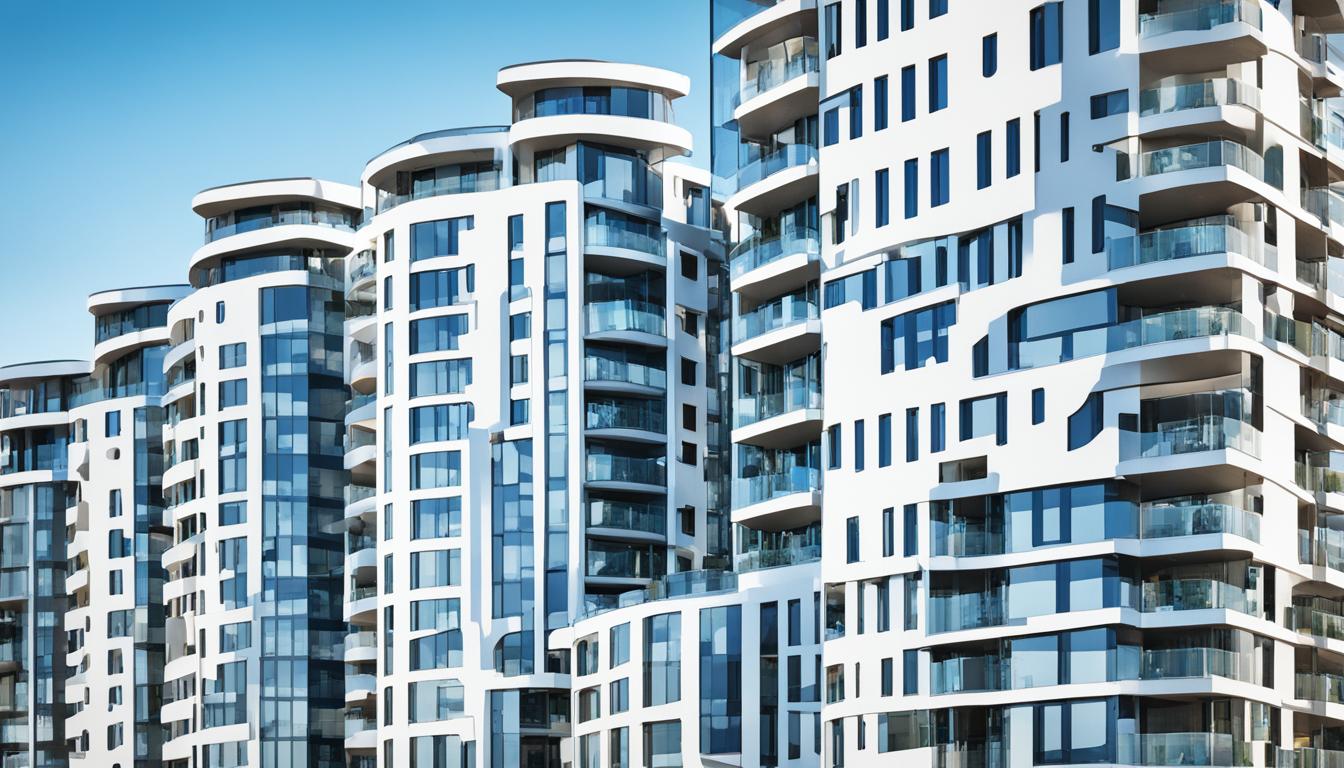
What to Look for When Buying a Policy for Buildings Insurance
When purchasing a policy for buildings insurance, it is important to carefully review the policy’s exclusions, which are the boundaries that insurers set for claims. Exclusions specify the situations or events that are not covered by the insurance policy. Common exclusions may include pre-existing damage, certain natural disasters, intentional acts, and wear and tear. It is crucial to understand these exclusions to avoid any surprises when it comes to making a claim.
Excesses are another important aspect to consider when buying a policy. Excess refers to the amount of money that the policyholder must contribute towards a claim. Different types of excesses may apply, such as compulsory excess, voluntary excess, or policy-specific excess. Understanding the excess structure is essential to ensure that it aligns with your budget and financial capabilities.
Comparing premiums from different insurers is crucial to find the best value for your buildings insurance coverage. It is important to consider the coverage provided, including the sum insured, level of protection, and any additional features or benefits. While it is essential to find a competitive premium, it is equally important to assess the overall value and suitability of the policy.
The level of customer service provided by the insurer should not be overlooked. A reputable insurer with excellent customer service can make the insurance experience smoother and more pleasant. Consider factors such as the insurer’s reputation, responsiveness, and ease of communication. Reading reviews and seeking recommendations can provide valuable insights into an insurer’s customer service track record.
By carefully considering the exclusions, excesses, premiums, and customer service offered by different insurers, property owners can make informed decisions when purchasing a buildings insurance policy. It is essential to strike a balance between adequate coverage and affordability while ensuring a positive customer experience throughout the insurance journey.
Factors to Consider
Key Points
Exclusions
– Review policy’s exclusions carefully
– Understand which situations or events are not covered
Excesses
– Determine the amount policyholder must contribute towards a claim
– Consider compulsory, voluntary, or policy-specific excess
Premiums
– Compare premiums from different insurers
– Assess coverage and additional features
– Seek overall value and suitability
Customer Service
– Consider insurer’s reputation and responsiveness
– Assess ease of communication
– Read reviews and seek recommendations

Landlord Home Emergency and Public Liability Insurance
As a landlord, it’s crucial to protect your investment and the well-being of your tenants. Two key insurance policies to consider are landlord home emergency insurance and public liability insurance.
Landlord Home Emergency Insurance
In the event of unforeseen emergencies such as a burst pipe or a broken heating system, landlord home emergency insurance provides quick access to professional help. This coverage ensures the safety and health of your tenants, allowing you to address and resolve urgent issues promptly.
With landlord home emergency insurance, you can have peace of mind knowing that qualified tradespeople will be on hand to handle emergency repairs, minimizing disruptions and maintaining the habitability of your property.
Public Liability Insurance
Public liability insurance is another essential coverage for landlords, especially for buildings with multiple residents and various individuals coming in contact with the property. This insurance protects you from legal action if someone sustains an injury on your property.
Accidents happen, and injuries can occur due to unforeseen circumstances. Public liability insurance ensures that you’re financially protected and can handle any legal claims related to injuries sustained by tenants, visitors, or third parties on your property.
Having public liability insurance not only safeguards your personal assets but also demonstrates your commitment to tenants’ safety and well-being.
Why Landlord Home Emergency and Public Liability Insurance are Important
Investing in landlord home emergency and public liability insurance is essential for several reasons:
Ensures the safety and well-being of your tenants in emergency situations
Provides quick access to professional help for urgent repairs
Minimizes potential disruptions and maintains habitability of the property
Protects you from legal action and financial liabilities in case of injuries
Demonstrates your commitment to tenant safety and satisfaction
By having landlord home emergency and public liability insurance, you can rest assured knowing that you’re taking proactive steps to mitigate risks and protect your investment.
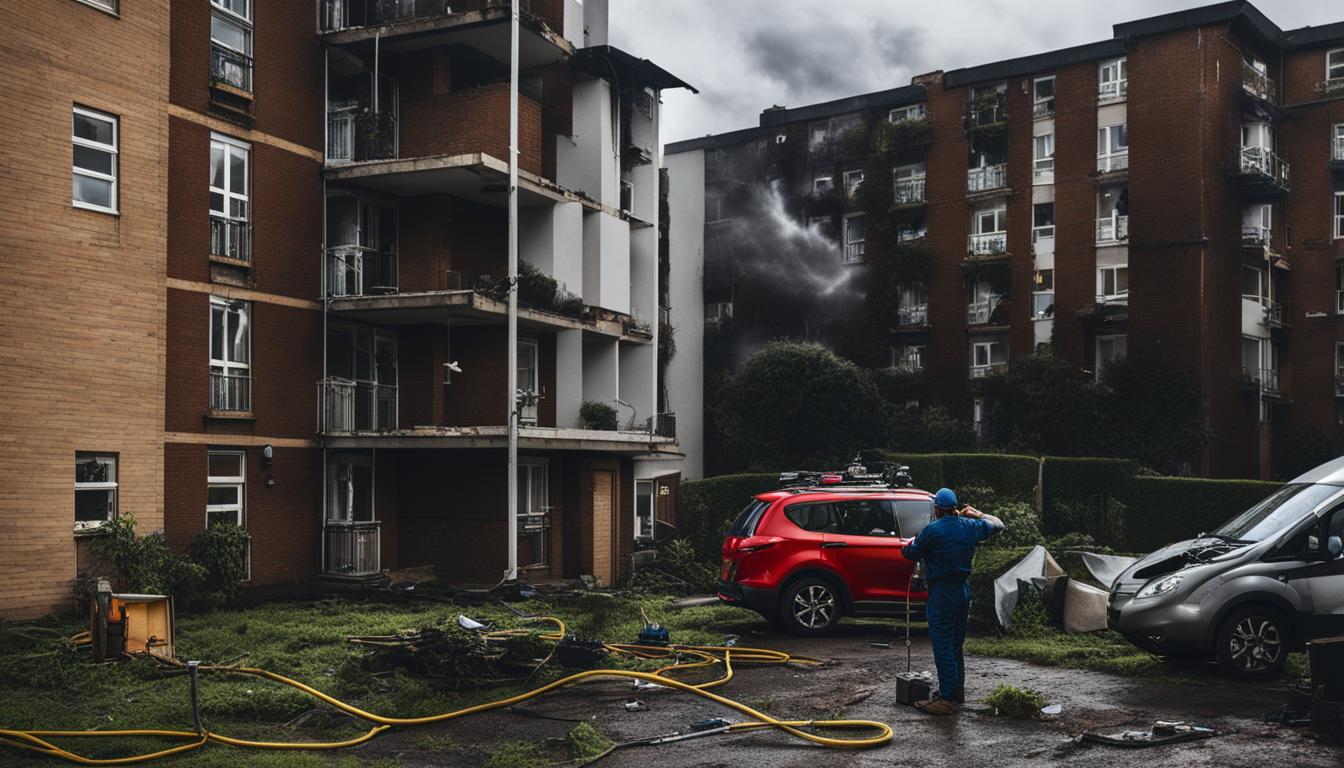
Landlord Home Emergency Insurance
Public Liability Insurance
Provides quick access to professional help for emergencies
Protects landlords from legal action in case of injuries
Covers urgent repairs for burst pipes and broken heating systems
Safeguards personal assets in the event of legal claims
Ensures safety and health of tenants
Demonstrates commitment to tenant safety
Alternative Accommodation and Flats Insurance
In the unfortunate event of a disaster rendering a block of flats uninhabitable, buildings insurance should help cover the financial loss. However, it is crucial to consider the needs of the residents who will require alternative accommodation during the restoration process. Most flat insurance policies include an allowance for alternative accommodation, ensuring that the displaced individuals have a place to stay until they can return to their homes.
Block of flats insurance is particularly important in this regard due to the higher number of residents who need to be accommodated. The policy should provide coverage for alternative accommodation expenses, so that residents are not burdened with additional costs during an already challenging time.
Table: Coverage for Alternative Accommodation
Insurance provider
Alternative accommodation coverage
ABC Insurance
Up to £X per person for X days
XYZ Insurers
Up to £X per policy for X days
DEF Assurance
Up to £X per person for X days
As the above table shows, different insurance providers offer varying levels of coverage for alternative accommodation. It is important to review the policy details and ensure that the coverage aligns with the needs of the residents in the event of an uninhabitable property.

“Having a suitable place to stay during the restoration period can greatly minimize the disruption caused by an uninhabitable property. It is essential for block of flats insurance policies to include coverage for alternative accommodation, providing peace of mind to both the property owners and their residents.” – Jane Smith, Insurance Expert
Rebuild Cost and Block Insurance Occupancy
In order to ensure adequate coverage for a block of flats, it is crucial to accurately determine the rebuild cost. This refers to the amount it would cost to completely rebuild the property based on materials and labor. Having an accurate estimate of the rebuild cost is essential, as it will help in choosing the appropriate level of insurance coverage.
Insurers may also inquire about the occupancy of the flats. This is because different types of tenants present different levels of risk. For example, unoccupied flats are considered to be higher risk, as they may be more susceptible to certain perils such as vandalism or theft. Additionally, certain types of tenants, like students, may also pose higher insurance risks.
By accurately assessing the rebuild cost and understanding the potential risks associated with different types of tenants, property owners can ensure that their block insurance policy provides comprehensive coverage for their specific situation.
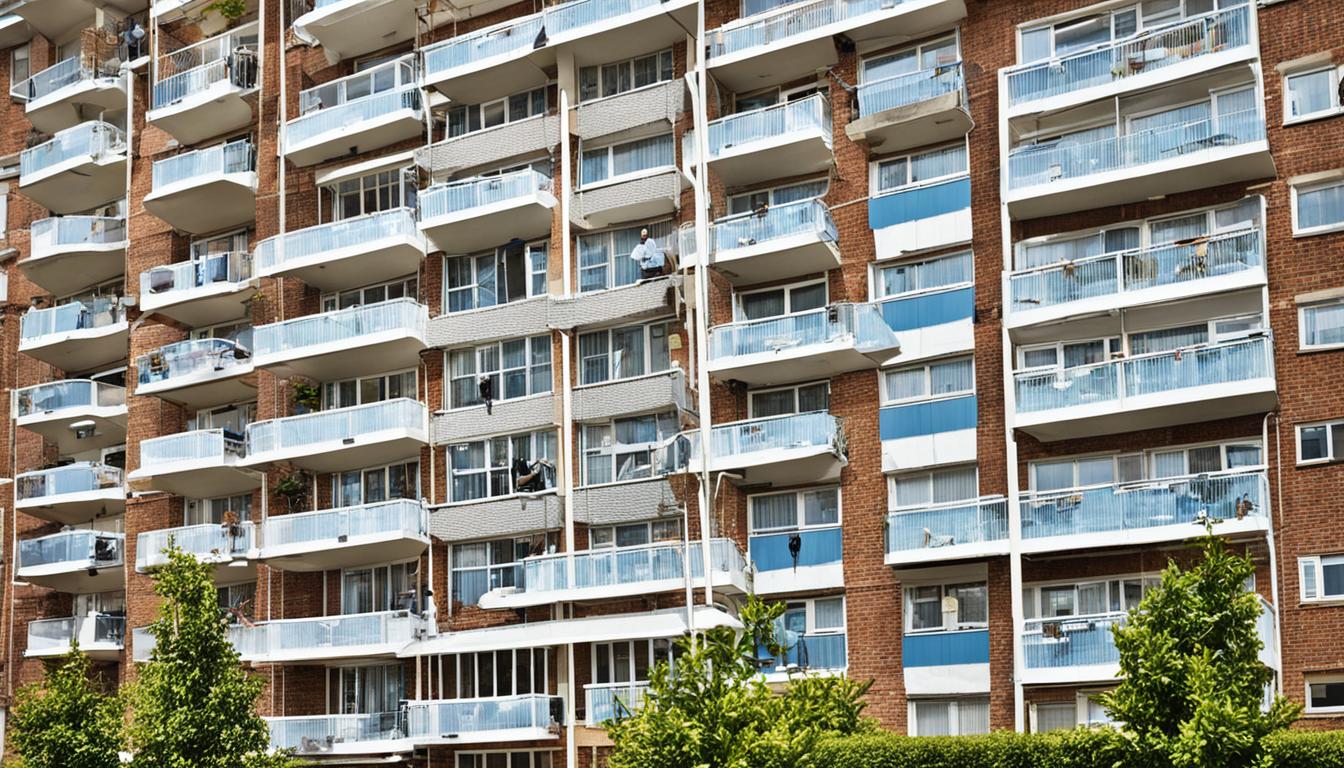
Block Insurance Claims History and Date of Construction
Insurers may inquire about the block insurance claims history to assess the risk profile of the property. This includes information about any previous claims made on the buildings insurance policy, such as the date, total cost, and details of the claim. By understanding the claims history, insurers can better determine the potential risks associated with the property and adjust the insurance coverage accordingly.
Another factor that insurers may inquire about is the date of construction of the block of flats. The date of construction helps insurers assess the age and condition of the property, as older buildings may have different risks compared to newer constructions. Additionally, insurers may also inquire whether the block of flats is listed.
Listed properties are buildings that meet specific criteria of historical or architectural significance and are protected by law. Insuring a listed property may require additional considerations and specialized coverage. Restoration or repairs for listed properties often need to adhere to authentic materials and methods, which can impact the cost of insurance. Therefore, insurers may take the listed status into account when determining the insurance premium for a block of flats.
Block Insurance Claims History and Date of Construction: Key Points
Insurers may ask about the block insurance claims history to assess the risk profile of the property.
Providing information about previous claims, including the date, total cost, and details, can help insurers determine potential risks.
The date of construction is important as it helps insurers assess the age and condition of the property.
Listed properties may require specialized coverage due to preservation requirements, which can impact the cost of insurance.
Factor
Importance
Block Insurance Claims History
Assesses the risk profile of the property
Date of Construction
Indicates the age and condition of the property
Listed Properties
May require specialized coverage due to preservation requirements
Joint Freeholders and Multi-Property Insurance
If you are joint freeholders for the block of flats, it’s important to provide your details when applying for insurance. This includes your date of birth and claims history, as it helps insurers assess the risk profile of the property. Additionally, having a management company authorized to act on behalf of the freeholders can streamline the insurance application process.
Property owners who have multiple properties may also benefit from considering multi-property insurance. This type of insurance allows you to cover all your properties under one policy, providing convenience and potential cost savings.
Benefits of Multi-Property Insurance
1. Simplified Insurance Process
2. Cost Savings with a Combined Policy
3. Flexibility to Add or Remove Properties Easily
4. Streamlined Renewals and Claims Process
In summary, joint freeholders should provide their details when applying for block of flats insurance, and considering multi-property insurance can be beneficial for property owners with multiple properties. These steps can ensure smooth insurance processes and potentially save you time and money.
Quote:
“Joint freeholders and multi-property insurance provide peace of mind for property owners with multiple investments. By streamlining the insurance process and potentially reducing costs, it’s a smart choice for those looking to protect their assets.”
Key Aspects to Look for When Buying Buildings Insurance
When purchasing buildings insurance, it is important to consider several key aspects that can greatly impact your coverage and overall experience. By focusing on these factors, you can ensure that you choose the right policy that aligns with your specific needs and provides the necessary protection for your property investment.
Exclusions: Examine the policy’s exclusions carefully. These are the specific situations or risks that the insurer will not cover. By choosing a policy with fewer exclusions, you can maximize your coverage and avoid unexpected surprises.
Excesses: The excess is the amount of money you are responsible for paying towards each claim before the insurer covers the rest. It is crucial to consider the excess and ensure that it is affordable for you in the event of a claim.
Premium: Compare premiums from different insurers to find the best value for your coverage. While cost shouldn’t be the sole determining factor, finding a policy that offers comprehensive coverage at a competitive premium is important.
Customer Service: Evaluate the level of customer service provided by the insurer. Dealing with a responsive and helpful customer service team can greatly enhance your overall experience and make the claims process smoother.
By taking these key aspects into account, you can make an informed decision when buying buildings insurance and ensure that you have the right coverage for your property. Remember, it’s not just about the price, but also the quality of the policy and the support you receive from the insurer.
“Paying attention to the exclusions, excesses, premium, and customer service can make a significant difference in your buildings insurance experience.”
Conclusion
Summing up, having comprehensive block of flats insurance is crucial for safeguarding your property investment. By carefully considering factors like rebuild cost, occupancy, claims history, and cover options such as public liability and landlord home emergency, you can ensure that you secure the right insurance policy at the right price. It is also important to understand the extent of coverage provided by buildings insurance and the significance of alternative accommodation in the event of a disaster, as this will provide peace of mind for both landlords and tenants.
In conclusion, when searching for block insurance, it is advisable to shop around, thoroughly review policy details, and select an insurer that prioritizes excellent customer service. By doing so, you can rest assured that you have obtained the most appropriate insurance coverage for your block of flats, mitigating potential risks and ensuring the protection of your valuable property investment.
To summarize, the key aspects to consider are rebuild cost, occupancy details, claims history, and the availability of additional covers. Obtaining an accurate rebuild cost estimate is essential, as it influences the coverage amount. Accurately disclosing occupancy details, including any unoccupied flats, ensures that your policy accurately reflects the risk profile of your property. A claims history can impact the premium you pay and, therefore, should be disclosed to the insurer. Lastly, considering additional covers like public liability and landlord home emergency provides added protection. By carefully evaluating these aspects and considering the final thoughts shared in this guide, you can make an informed decision and select the most suitable block of flats insurance policy.
FAQ
What is block of flats insurance?
Block of flats insurance is a specialized insurance policy that focuses on the buildings insurance for a block of flats. It covers the physical structure of the property and takes into account the unique risks associated with a block of flats, such as different types of tenants and the potential for unoccupied flats. Additional covers like public liability and landlord home emergency may also be included.
What does buildings insurance cover for a block of flats?
Buildings insurance for a block of flats covers the physical structure of the property, including the walls, flooring, and enduring fixtures and fittings such as fitted kitchens and bathrooms. It also provides coverage for risks such as water leaks and subsidence damage. In the event of a disaster, buildings insurance may fully cover the cost of reconstructing the building.
What should I consider when purchasing a block insurance policy?
When obtaining a block insurance policy, consider factors such as the rebuild cost of the property, accurately identifying the occupancy of the flats, disclosing any claims history, providing the date of construction, and providing details of joint freeholders if applicable. Property owners with multiple properties may also consider multi-property insurance to streamline the process.
What should I look for when buying a policy for buildings insurance?
When purchasing buildings insurance, carefully review the policy’s exclusions and excesses. Exclusions are the boundaries that insurers set for claims, and excesses are the mandatory contributions paid towards claims. Comparing premiums from different insurers and evaluating the level of customer service provided is also essential.
What is landlord home emergency and public liability insurance?
Landlord home emergency insurance provides quick access to professional help for unforeseen emergencies such as a burst pipe or broken heating system, ensuring the safety and health of tenants. Public liability insurance protects landlords from legal action if the building causes someone an injury, which is particularly important for buildings with multiple residents.
What happens if the property becomes uninhabitable?
In the event of a disaster, buildings insurance should help cover the financial loss of a block of flats, but residents will still need alternative accommodation. Most flat insurance policies include an allowance for alternative accommodation if the property becomes uninhabitable, which is particularly important for a block of flats insurance due to the higher number of residents affected.
How is rebuild cost and block insurance occupancy determined?
The rebuild cost of a block of flats is the amount it would cost to rebuild the property based on materials and labor. It is important to accurately determine this cost to ensure adequate coverage. Insurers may ask about the occupancy of the flats because different types of tenants present different levels of risk, and unoccupied flats are considered higher risk.
What information do insurers need about claims history and date of construction?
Insurers may inquire about any previous claims on buildings insurance, including the date, total cost, and details of the claim. This information is important for assessing the risk profile of the property. Additionally, insurers may ask about the date of construction and whether the block of flats is listed, as listed properties may require restoration using authentic materials and methods, which can impact the cost of insurance.
What if there are joint freeholders or multiple properties?
If there are joint freeholders for the block of flats, their details may be required for the insurance policy, including their date of birth and claims history. Having a management company authorized to act for the freeholders can streamline the insurance application process. Property owners with multiple properties may also consider multi-property insurance to cover all their properties under one policy.
What are the key aspects to look for when buying buildings insurance?
When purchasing buildings insurance, key aspects to consider include the policy’s exclusions, excesses, premiums, and customer service. Exclusions can significantly impact the coverage, so it is crucial to choose a policy with fewer exclusions that aligns with your specific needs. The excess, or contribution towards claims, should be carefully considered to ensure it is affordable.

